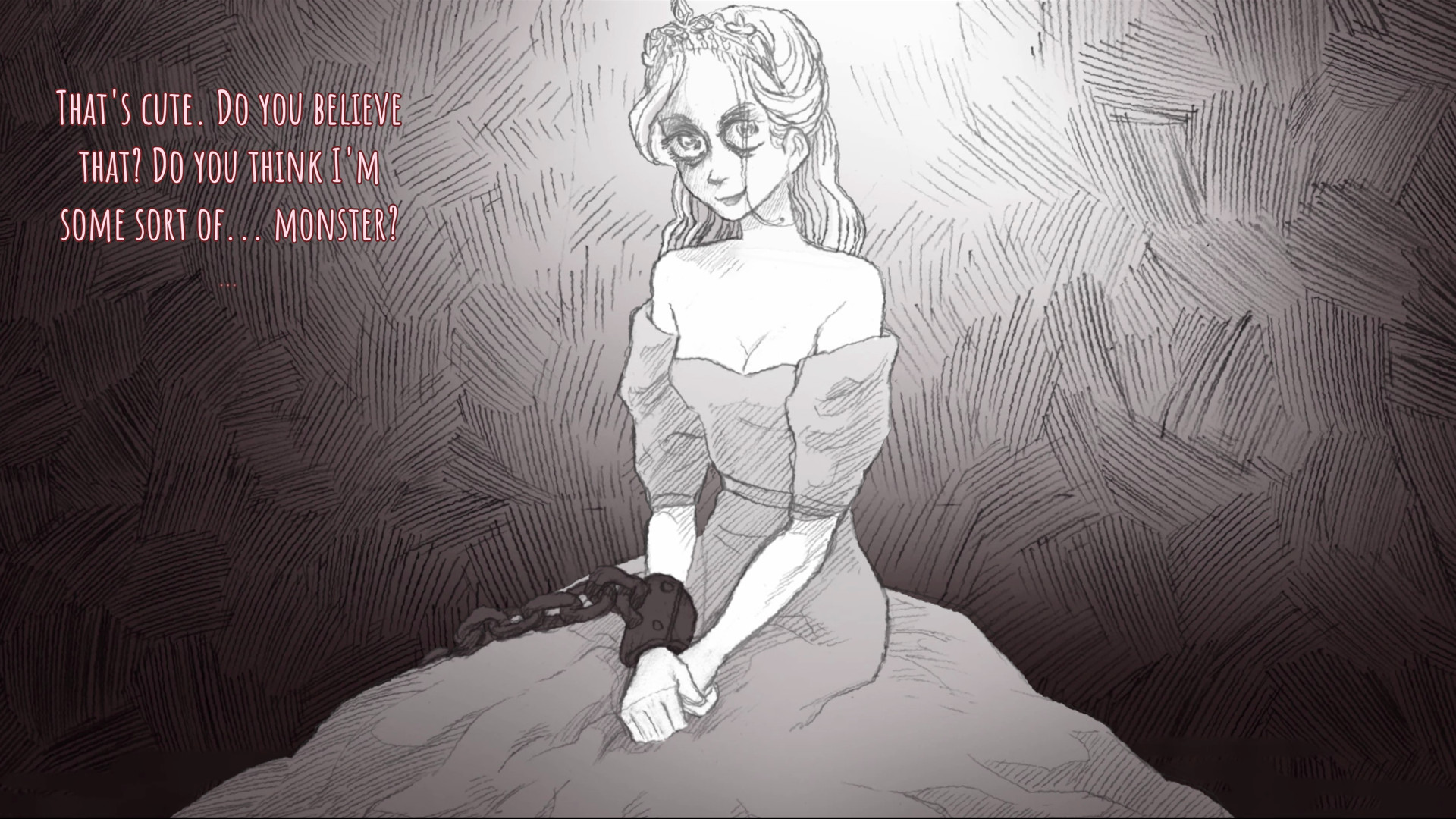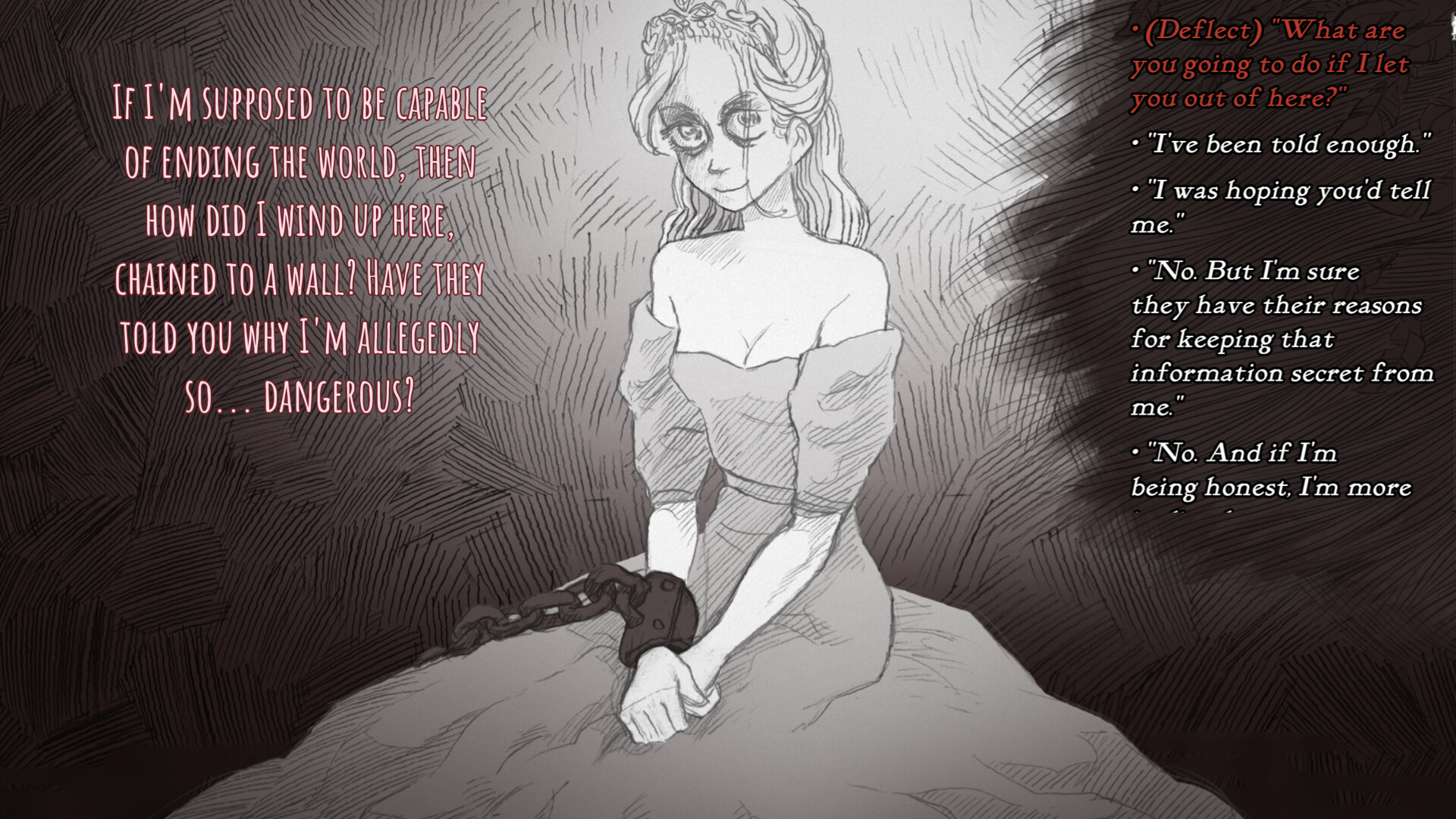It’s been a while since I saw a good visual novel with a deep storyline, good graphics and very good sound. Now comes Slay the Princess. But let’s start from the beginning: the whole game is built around the narrative and the heroes and the atmosphere created by the interactions.
Development was handled by a small indie studio, Black Tabby Games, founded by husband and wife team Abby Howard and Tony Toward-Arias. Abby is responsible for the game’s graphics, with everything, literally everything down to the smallest detail, created by herself. Every background, sprite and character is hand-drawn, making the graphics both beautiful and uniquely charming.
Jonathan Sims and Nicole Goodnight provided the voices for the characters and did a great job. Maintaining the identity of each voice in the game while giving them unique characteristics is an incredibly difficult task. Composer Brandon Boone wrote the soundtrack.
Grab the dagger and head to the lonely road in the middle of the forest. This is our review of Slay the Princess.
The concept of the game is deceptively simple. This story starts on a path in the middle of the forest. The longer you stay in place, the more it becomes clear that you have to figure out where that path leads. As you look around in confusion, you can hear the narrator’s voice in your head, urging you to follow the path to a house right in front of you and kill the princess who is being held captive in the basement. You must do it to save the world!..
The game immediately gives you the opportunity to pester the narrator with some questions, but he doesn’t offer many explanations, mostly just some vague hints. This doesn’t help, as you may have dozens of questions running through your head: Is it worth killing her? How and why was she imprisoned? Why would the world be doomed if you don’t kill the princess? Could the narrator be lying? What if you defy him, what if… what if you just go ahead and kill the princess without remorse, or just stop on that road without making a decision?
The narrator is a guiding hand, giving you advice and describing the surroundings vividly. He may be a little quiet and not very eloquent at first, but he becomes more talkative as the plot gets more exciting. And he’s not the only one…
As you approach the cottage, the narrator lays down the rules: do not talk to the princess, she will surely try to lie and deceive you! Do not even think about freeing her, you would damn the world. And finally, you must kill her, and then everything will be fine.
And then we hear another voice, that of a hero. He vehemently contradicts the narrator and parries his suggestions. After all, the hero’s path is to save princesses, not kill them!

This is how you get to know another voice that accompanies the protagonist through this story. The further you progress in the plot, the more voices will appear.
Your choices determine which voices will speak in the hero’s head. Are you scared? Then you will hear the voice of the coward. Broken? Then there will be the broken one echoing your thoughts. The skeptic, the paranoid, the stubborn, the hunted, the lover, the opportunist, the hero… each voice is unique, with its own character and sound.
And each of them shows themselves and the protagonist in a new light. Their discussions and conversations reveal a lot about the world of the game and the plot. How many voices can there be in one head? And yet it feels like someone is missing…
At this moment, the game gives you complete freedom – within the game framework, of course. You can take the dagger, go down the stairs to the basement and kill the princess without exchanging a word. Or you can leave the dagger lying and try to talk to her. Try to free her by giving her your trust, or suspect duplicity and betray her before she gets the chance. The plot reacts sharply to your questions to the narrator, to your conversations and even your thoughts. And then it changes accordingly.
After your first meeting with the princess, you’re on the road again. Only this time, everything looks somehow different. The narrator starts his tirade again about how you have to keep going, get into the house, take the knife and kill the princess. You already know every word he says and know that this has happened before.
But his voice is drowned out by another, the voice of the subconscious. Fascinating? Very much so! But when you go down to the basement, you will find that the princess has changed too. And she remembers your last meeting. The voices also remember how the last meeting ended, which confuses the narrator, since he is the only person who doesn’t know this.
He insists that this can only mean that your previous choices have destroyed the entire world. Well, let’s take that into account and maybe try to do things differently this time? And yet, regardless of your choices, it’s back to the forest path, changed again. This time, the narrator doesn’t even get a chance to say a word before the voices in your head are already entering into a lively discussion.

In each cycle, the plot presents itself to you from a new perspective, the visual elements adapt, the conversations become more intense and informative, and something changes.
There are, however, some things that remain constant. The narrator is always with you, he is always categorically against the princess (no matter what), he always provides only the bare minimum of information, always answers questions quickly and evasively. The narrator obviously has his own agenda, and he insists that the princess is poison and the protagonist is medicine.
The house and the dungeon the princess is in are also unchangeable. The princess is an independent character, but her appearance, behavior and mood change depending on the hero’s decisions.
If the protagonist is afraid to meet her, then you will meet a monster. If he tries to woo her, then you will meet a sweet and kind princess. But the appearance of a naive beauty is not the last, and the princess will turn into a monstrosity if you try to take advantage of the moment and stab her with the dagger.
However, if you are guided by such logic, you also have the chance to correct the mistakes of the past!
It always comes back to the untouched blade. The weapon is a sign of your attitude towards the princess. Picking it up means unconsciously creating situations in which we are forced to use it. By ignoring the blade, the hero increases the chances of a more cordial and friendly meeting.
There is also the mirror that appears in the cabin after the very first cycle. The voices comment on it, but the narrator does not see it, which is a very strange phenomenon. And every time we try to dust it off, we are left with nothing. At the very end of the game, some light is shed on what the mirror actually is.

After completing several cycles, you can reach the end, where the plot unfolds from an unexpected side. You will learn who the princess is, who the narrator is and what he has been hiding, and even who you are.
But simply reading about it is hollow and doesn’t convey even a portion of what you will actually feel when you reach the end of the game itself. I hope you try to experience it yourself, find out the whole truth, learn all the different sides of the princess, and study the voices in the protagonist’s subconscious, revealing the narrator’s secrets and his almost manic belief that killing the princess will save the world.
And also the secret of the mirror. At the very end, you have to make a decision that determines how your story ends. Not just the game, but your story.
Slay the Princess is a fantastic game where you read dialogues carefully and try to figure out who is lying and who is telling the truth. Or maybe everyone is lying or just has their own truth? Once you start, it’s very difficult to put the game down because there is so much more to see.
It’s hard to ignore how much love the developers put into this project. Everything in Slay the Princess depends on how YOU see the game, and everyone will understand it in their own way.

